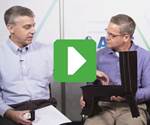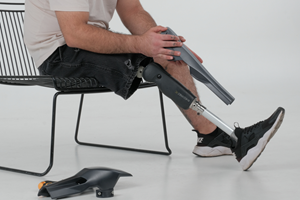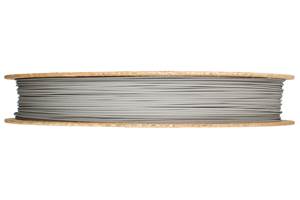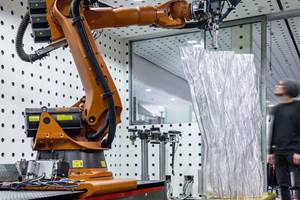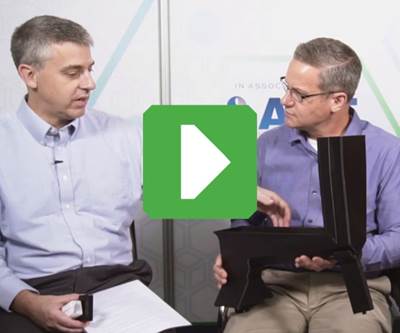
Pella Corporation is a high-volume, high-variability manufacturer. Windows and doors in different styles and configurations for different customers flow down the production line in continuous sequence. Additive manufacturing now serves this production in many different ways, as I saw when I visited the company's headquarters plant in Pella, Iowa. Read my report below.
Kurtis Webb, engineering manager with Pella Corporation and a 24-year veteran of this company, was an advocate for additive manufacturing when I first met him in 2018. Pella is the Iowa-based maker of windows and doors — homeowners might recognize the name. As Webb first began to succeed with applying 3D printing to make hardware components for machines used in window and door production, he also showed company engineering teams these successes, inviting them to imagine the applications for AM they might find within their own different areas. He recognized additive could play a broad, empowering role touching many aspects of the company’s work, and he wanted to see its use expand.

Kurtis Webb, engineering manager, has worked to advance additive manufacturing within Pella and help realize its many promises for cost savings and efficiency gain for the company. His challenge now is much less about advocacy and more about managing AM demand. He and Aaron Ryan (below) oversee two different 3D printing hubs at the HQ factory.
“There were a lot of sample parts left on engineers’ desks,” he says.
Today, things are different. That outreach is now a much smaller part of Webb’s job for a simple reason: The outreach worked. Additive manufacturing is an accepted and commonplace part of Pella Corporation’s operations today. Persuading engineers to consider 3D printing is no longer the challenge. Managing the demand for 3D printing is the challenge.
I went to the company’s headquarters facility in Pella, Iowa, to see this. That is, to see AM in action within a manufacturing organization now realizing various different promises of the capability all at once. For Pella, additive manufacturing plays roles that speed innovation, aid the capabilities of production team members, and improve custom equipment dedicated to window and door production, all while also providing an alternate production pathway for low-quantity end-use parts.

The Steady Set system allows for window installation from the inside. Key to this system is a special bracket design, and the key to developing and perfecting these brackets was rapid iteration via 3D printing. The Design Assurance Lab led by Aaron Ryan, seen here, was instrumental to this work.
This broad scope of AM adoption is valuable to see, because other manufacturing organizations have their AM advocates as well — and they need to see what they are aiming for. That is, these advocates must prepare to succeed. The special promise and challenge of additive manufacturing is found in the way it delivers value in different ways to various disciplines and stakeholders, including many beyond manufacturing. This breadth of AM’s application and impact has to be confronted as AM adoption advances.

AM capacity at the Pella, Iowa, site is in two locations. A print farm in the Design Assurance Lab makes prototypes, tooling and production parts.
For Pella, enabling all that 3D printing can do ultimately meant growing through multiple groups focused on leveraging AM in different ways. Today, two groups at Pella’s headquarters site both employ 3D printing extensively — in fact, they both employ the same type of 3D printing: polymer deposition or fused filament fabrication (FFF) — yet these two groups succeed by emphasizing different needs. The Manufacturing and Engineering Services group focused on process engineering is where much of the AM advocacy originated several years ago, while the Design Assurance Lab, focused on product development, provides a different AM role that is just as critical. The groups’ equipment is separate and their aims are separate, and yet they also support one another by interacting and sharing capacity routinely. Here is what their combined efforts in AM look like for Pella today.

The Manufacturing Engineering Services group uses larger-scale 3D printing capacity to make (among other things) hardware for custom machines. Because the two processes both are characterized by long cycle times, Pella runs additive manufacturing and electrical discharge machining (EDM) in this same room, overseen by a single team member.
High-Volume, High-Variability Production
Pella is a make-to-order manufacturer. Serving customer tastes plus the architectural parameters of both new and existing homes and buildings means that windows and doors are a product subject to considerable variety, and the production process has to accommodate this. I saw this as one of the more visible distinctions of Pella’s production operation when I was touring the Pella, Iowa, plant. This plant — one of 18 company factories — is large enough that touring it in reasonable time requires a golf cart, yet the large-scale operation does not involve high-volume repetition like other manufacturing facilities. At the Pella factory, a steady line of windows progressing through an operation such as securing the glass pane might include at most four identical windows in a row before a different design comes next in line, and the progression might even feature a dozen different windows in a row that are headed to a dozen different homes.

Building custom machines used in Pella's own production is perhaps where additive manufacturing has had the most extensive effect for the company.
Thus, the production is both high-volume and highly variable. The Manufacturing and Engineering Services team, which Webb leads, serves this need by developing and producing both special hardware for production machinery devoted to window and door production, as well as special tools for production team members performing manual steps as part of this work.
Meanwhile, the business of windows and doors is also highly competitive. The Design Assurance Lab, led by Aaron Ryan, engineering program manager, serves new product development and ultimately the sales and marketing effort by allowing new products to be fully realized and sped to market ahead of similar ideas other window makers might be pursuing.

Ducting, for example, is now easy to engineer to the precise geometric space and need. These ducts for a cutting and grinding operation were easy to make through 3D printing, and would have been costly to have made through metal bending.
Still, 3D printing capacity is, among other things, flexible and fungible — to the extent that all the AM capability in both of these groups is essentially available for all these uses. Webb’s group uses larger-travel FFF 3D printers from 3ntr, among other AM equipment. Ryan’s group uses a print farm of around 24 small 3D printers from Bambu Lab, Creality and Markforged. This latter group also has a selective laser sintering machine from 3D Systems. The two groups communicate and coordinate, and routinely print work for one another.
The scope of that work covers several very different application categories. As I toured the headquarters factory, I spoke with Ryan and Webb to understand the extent and importance of AM’s support of engineering and production. One capability, 3D printing via FFF, addresses many needs in parallel. This is where the advocacy for 3D printing had been leading — at Pella today, 3D printing now delivers on all of the following:
1. 3D Printing for Product Development
Pella’s “Steady Set” window system offers a notable example of how additive manufacturing aids new product development and introduction. The breakthrough of the Steady Set system is the ability it provides for installing a window from the inside of a building, in cases where outside installation had been the only possibility until now. This makes window installation easier and faster, not to mention safer — all of which is compelling for construction firms suffering from a shortfall in skilled labor very similar to that of manufacturing. The hardware of the Steady Set system relies on an innovative bracket design that, after many iterations, delivered the reliable installation simplicity Pella was aiming for.

Brackets were prototyped first via selective laser sintering. As the design neared completion, early tooling for metal forming was 3D printed as well. Watch a video filmed onsite for more about additive manufacturing for product development at Pella.
And iteration was the key. There is no way to refine or prove out a complex, novel component like the Steady Set bracket except by using real physical pieces, says Ryan. Slow prototyping therefore would slow down the pace of the idea becoming real, he says, while any of Pella’s competitors might have been (as far as the company knows) working on a similar idea. 3D printing allows for fast prototyping and fast iteration, and it does so all through the product’s maturation, with additive able to make not only 3D printed early versions of parts but also short-lead-time mold or die tooling as the product moves closer to production.
Windows and doors are, again, high-variation products with many features available for aesthetic or operational improvement. There is always something being advanced, refined or tweaked, Ryan says, and as a result, a significant share of the print farm’s capacity in his group is devoted to making prototypes, usually functional, and making them quickly enough to keep the new ideas moving.
2. 3D Printing for Short-Run Production
Along with functional prototypes, functional parts are another promise. Pella’s production is high volume, meaning plastic hardware for windows and doors is generally made via molding. But some components for special window and door designs are needed in quantities on the order of thousands per year, not hundreds of thousands. For these, production via 3D printing is coming to be seen as the easiest and most economical approach. Ryan says 12 plastic part numbers so far are made this way, without any mold tooling needed.

About a dozen low-quantity production parts are now made exclusively via 3D printing. Ryan holds a sample.
Smaller components are produced on the print farm machines. Even though the role of the group overseeing these machines is design, AM capacity is flexible, and the small 3D printers serve as capable production equipment. The team running the print farm therefore keeps inventory of the production components stocked by running these items as a routine part of allocating capacity on these machines.

A custom tool for installing weather stripping. This tool made via 3D printing is used in various Pella sites. The scene at the very top of this page shows a Pella team member about to use the tool.
3. 3D Printing for Internal Tooling

Drill guides are perhaps the most straightforward example of tooling made via 3D printing. Making these tools from composite provides for guides that are rugged enough for production but soft enough not to accidentally mar the product.
On Pella’s factory floor, 3D printing serves the needs of high-mix production by equipping the people who are responding to this mix.

Here is tooling for a hand tool. The 3D printed fitting assures this nail gun applies its fastener at exactly the right angle for a window pane sealing piece. Learn about this and other tooling wins in our video about 3D printed work aids at Pella.
Many production operations in the factory are manual because a human operator or technician can adapt more readily and reliably than an automated system to, say, applying weather stripping to windows of many different sizes in a row. AM has proven to be an invaluable complement, because it offers the way to give team members at different stations exactly the tool needed for performing a manual operation quickly.

For the nail gun operation, the 3D printed fitting saves cost and time by allowing the operation to be done repeatably and quickly, without relying on operator finesse and the corresponding chance for error.
Weather stripping is an example. A Pella hand tool customized to the needs of Pella weather stripping installation is in use throughout production in various company facilities. (See photo — and also see it in use in our video.) Webb’s group supports development of tools such as this, and he estimates that there are now 50 to 60 different 3D printed hand-tool inventions routinely aiding factory team members throughout the company.
Many are simple in conception, but would be prohibitively difficult to realize except through additive. One of these is a 3D printed fitting around a standard nail gun holding the power tool at exactly the best angle for nailing a piece that seals a glass pane. Previously, this nailing entailed finesse, and therefore a high error rate. With the 3D printed tool, the operation is reliable, fast and finesse-free.
4. 3D Printing for Machine Building
Making custom machines is perhaps the most impactful use of AM for Pella. This is the application Webb most wanted to pursue when he first started exploring AM for functional parts. Because there are no off-the-shelf window-making machines — at least not to suit production at Pella’s complexity and scale — the success of the company’s production is partly determined by the effectiveness of machines the company invents itself for its own manufacturing. Serving this need is the primary purpose of Webb’s group, which also employs conventional manufacturing equipment such as CNC machine tools. But for certain critical items, Webb saw how slow it was for making a custom hardware component to have to involve multiple setups on a machine tool along with a machinist overseeing the job. Additive manufacturing introduced the freedom to realize complex component geometries through essentially unattended fabrication, with the 3D printers running through the night. Today, says Webb, “For a custom machine that includes hundreds of individual pieces and parts we design, there is an ever-growing number of 3D printed parts.”
Design Still Offers Opportunity
There remains a role for advocacy, Webb says. Its aim is more nuanced now. There is comparatively little urging engineers to employ 3D printing today, because they know its value as a provider of tools, prototypes, complex geometries, and cost and lead time savings. They know its many different uses.
However, “We are still designing conventionally,” Webb says. This is the area where he now sees the chance to improve. “Additive would be even more effective if we could more often design for AM from the beginning.” He is trying to lead by example in the tools and parts his group gets to have an early hand in developing.
One particular advocacy aid that is no longer needed to the same extent is the 3D printed sample part just for the sake of introducing 3D printing. There are far fewer trinkets made today, he says, and there is much less of the simple curiosity-feeding and confidence-winning conversation that went with those trinkets. Webb, Ryan and the organization have gone to the next stage, which has its own challenges.
“In the past, we were saying yes to a lot of jobs we shouldn’t have,” Webb recalls. That is, parts poorly suited to AM. “Now, we are taking care to say ‘no’ when we should, so we can focus on all the best opportunities where additive can deliver the win.”
Related Content
In Armenia, Personalized 3D Printed Shields Improve Fit for Prosthetics
The ongoing conflict in Armenia has left many of its citizens sustaining injuries, especially the loss of limbs. With difficulty in accessing quality health care, many people have poorly fitted prosthetics. The solution lies in 3D modeling and printing customizable prosthetic case covers enabling better healing outcomes and comfort for patients.
Read MoreVirtual Foundry’s M300 Tool Steel Filamet Offers Strength, Versatility for FFF 3D Printing
The Virtual Foundry developed its M300 Tool Steel Filamet material for fused filament fabrication, offering compatibility with a variety of 3D printers.
Read More3D Printing Brings Sustainability, Accessibility to Glass Manufacturing
Australian startup Maple Glass Printing has developed a process for extruding glass into artwork, lab implements and architectural elements. Along the way, the company has also found more efficient ways of recycling this material.
Read MoreFor Coast Guard, AM Adoption Begins With “MacGyver-ish” Crew Members Who Are Using 3D Printing Already
AM suits the Coast Guard’s culture of shipboard problem-solving, says Surface Fleet AM lead. Here is how 3D printers on ships promise to deliver not just substantial cost savings but also an aid to crew capabilities and morale.
Read MoreRead Next
Video: The Pella Corporation Is Succeeding With 3D-Printed Tooling
An engineering leader with the window and door maker shows examples of the tooling and machine parts now produced for the company's manufacturing processes using 3D printing.
Read MoreVideo: 3D Printed Hand Tools in Action on Pella Corporation Factory Tour
Examples include an invention for quickly installing window and door weather stripping, a fitting for giving the proper angle to a nail gun, and a clip for which the color is an important feature.
Read MoreVideo: AM for Product Development at Pella Corporation
Speed to market is a critical advantage 3D printing can enable. For its new product innovations, Pella iterates quickly using prototypes and tooling produced via AM.
Read More


